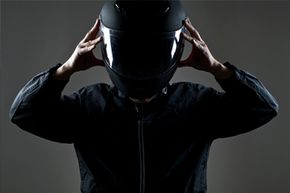The variety of motorcycle-helmet styles, brands and fits on the market can get overwhelming quickly. This should help narrow down the options: A full-face motorcycle helmet is the safest kind of helmet to buy.
This helmet will provide the most protection in a motorcycle crash, because it provides the most coverage and support. Of motorcycle crashes that involve impacts to the head, 45 percent of victims suffer injuries to the face — a compelling argument for a helmet with face protection [source: Siler]. Don't get tempted by style helmets, which look like full-face helmets except for the face part — the part that stretches across the chin is what makes the difference. Half helmets are good for protecting the top of the head but not the back of the head or the face.
Advertisement
It's pretty clear: More protection is better. Yet debate remains among riders. Why? There always will be some riders who prioritize comfort over safety. Some motorcycle riders don't wear helmets at all; others prefer helmets with less coverage because they believe they're lighter or cooler. Some riders claim full-face helmets impair peripheral vision, although that has been demonstrated to be untrue. Full-face helmets allow for 105 degrees of peripheral vision, and people only have 90 degrees of peripheral vision [source: Siler].
To choose a full-face helmet, first check for safety certifications. All helmets sold in the United States should bear a U.S. Department of Transportation certification sticker on the back. Some also have stickers from the Snell Memorial Foundation, a private organization that tests helmets. Consider the optional Snell approval a bonus, as many of its standards overlap with the DOT rules (but don't not buy a helmet that only carries the Snell sticker). A third standard, known as the European ECE 22.05, means that the helmet has passed the minimum European safety tests, some of which are stricter than American tests. An ECE 22.05 helmet is a great thing to have, but in the U.S. it still must have DOT approval.
Finally, find a helmet that fits by trying a lot of them on. Your helmet should be snug enough that it doesn't jiggle or turn on your head, even with the strap undone. However, there should be no points of pressure or tension. Don't get attached to a particular model or color combination: If it doesn't fit, it's not the safest helmet.
Advertisement



